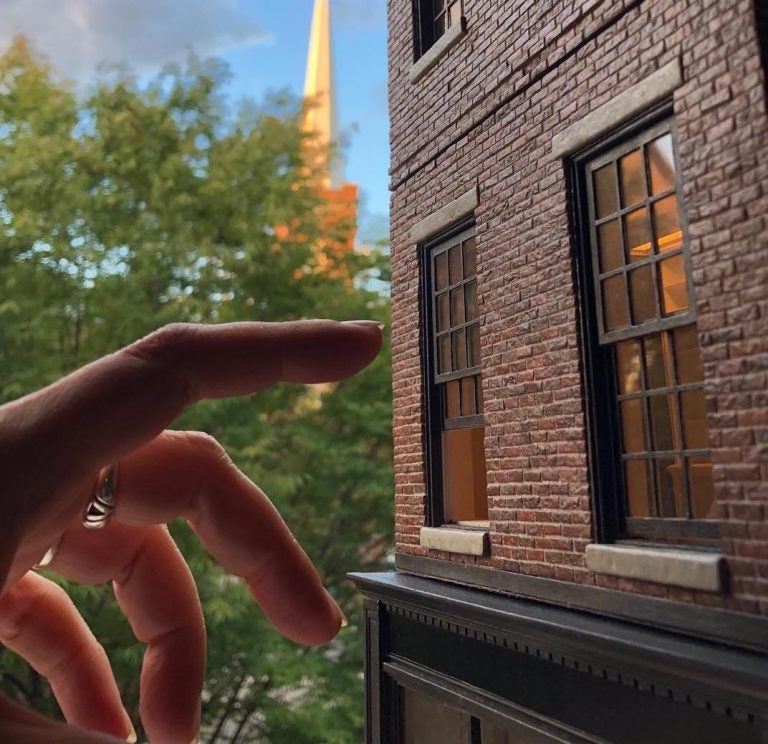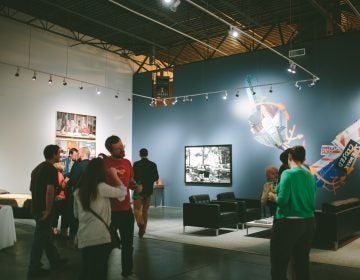Meet the architect building tiny rowhouses with sushi mats and old watches
Virginia Kerr’s whole perfect gallery, with floor-to-ceiling windows, hardwood floors and a beautiful front door, lives inside a cigar box.

Virginia S. Kerr creates rowhouses in 1:24 scale. (Virginia S. Kerr/litillby_v )
Virginia Kerr always wanted to own a house in Society Hill. A brick rowhouse. She also dreamed of having her paintings exhibited in a gallery.
Now, both those dreams have come true for the Venezuela-born Philadelphia artist, though perhaps on a smaller scale than imagined.
“I thought, why don’t I make my own gallery, and have my own exhibition?” she said.
The track lights above Kerr are trained on a vibrant abstract painting on a white wall.
The painting is about the size of a matchbox. The track lights no bigger than TicTacs.
The whole perfect gallery, with floor-to-ceiling windows, hardwood floors and a beautiful front door, lives inside a cigar box. It’s the first floor of Kerr’s dream house. Stack two more cigar boxes on top, and you have a typical Philadelphia brick rowhouse outfitted with every last detail.
The painting on the gallery wall is a tiny, exact replica of an oil painting Kerr made years ago. She has created little replicas of many of her big paintings.
Kerr is trained as an architect. She preferred modern houses and buildings until she moved to Philadelphia and discovered its historic homes.
“I came here and I was working in restoration and fell in love,” she said.
Now she’s shifted her career toward building miniature houses on a 1:24 scale.
“That’s how you build models as an architect,” she said.
By comparison, doll houses are typically on a 1:12 scale. She uses mostly recycled materials. She cuts her bricks from egg cartons with an exacto knife. She paints them, grouts them, paints them again until they have the patina of weathered rowhouse masonry.
The tiny door brass handle on the gallery? “This is my favorite thing,” Kerr said. She opens a drawer filled with the littlest knobs, springs and gear wheels. “These are the pieces of old watches.”
The intricate, shiny parquet floor is made from pieces of a sushi mat, which Kerr glued together and sanded down.
In another cigar box, Kerr built a kitchen. The backsplash behind the sink looks like a tile mosaic in sparkling shades of blue. It’s made from paint sample cards, which Kerr cut into miniscule pieces.
She also makes all of her own tiny lighting fixtures, and creates the electrical wiring to go with it.
Kerr spent most of her early years in Venezuela. Her family moved a lot when she was a child.
“Before every move, I would survey the house where we lived,” she recalled. She noted down all of the details and made sketches. “And then I would draw a version of that house, how I would like it.”
Kerr said she’s a perfectionist. Building tiny model houses instead of big structures allows her to have more control over every little detail. It also means her work fits easily into her small South Philly apartment. And, she can envision and create with liberty.
“Should I make a deck, a roof deck?” Kerr said about her tiny creation. “A Philadelphia house needs a roof deck.”
Her big dream is to build an entire block of Philadelphia rowhouses at a 1:24 scale, complete with a little urban park in a public square. She’s already training a bonsai tree in her kitchen to be the center piece for that outdoor space.
Despite the hours and hours she spends cutting, painting, and gluing on details with tweezers, Kerr said she won’t have a problem parting ways and selling these pieces.
“I don’t love them once they’re done,” Kerr said. “I don’t want to see them, because I’m done.”
Maiken Scott’s interview with Virginia Kerr is part of this week’s edition of The Pulse; Man-Made Worlds
WHYY is your source for fact-based, in-depth journalism and information. As a nonprofit organization, we rely on financial support from readers like you. Please give today.







